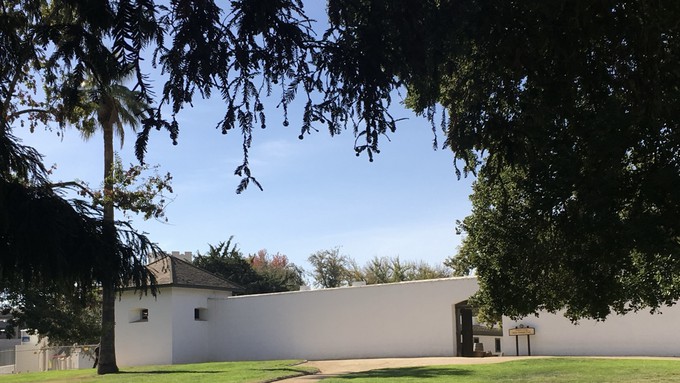
Sacramento Tree Foundation offers ‘Tree Identification’ workshop, walking tour

The area around Sutter’s Fort includes a range of different trees. Learn how to identify the city’s trees during an online webinar and a weekend walking tour. Kathy Morrison
Hosted by the Sacramento Tree Foundation, “Tree Identification 101” explores the beauty of our urban forest while attaching names to these impressive plants.
Offered at 7:30 p.m. Thursday, Nov. 14, this free webinar also points out the trees that thrive in Sacramento and which choices may be best for your own landscape.
“Join us via Zoom to learn basic principles of classifying and identifying Sacramento’s best trees,” says SacTree. “This brand-new class is for budding tree enthusiasts to learn the botanical basics of how to name and recognize various plant parts so you can learn to identify Sacramento’s trees. Knowing tree and leaf parts will allow you to key out tree species on your own and we’ll show you how!”
SacTree's Pamela Sanchez, an ISA Certified Arborist and a specialist in urban forestry, will lead the webinar. “Pamela’s passion for connecting people with their urban canopy makes this workshop a must!” adds SacTree.
“Tree Identification 101” is open to everyone at all skill levels. Space is limited and advance registration is required to receive the webinar Zoom link. Sign up here: https://sactree.org/event/tree-identification-101-webinar/
Want to see (and ID) trees in person? This webinar pairs nicely with an upcoming walking tour, also hosted by SacTree.
“Autumn Tree Tour of Southside Park” will use this Sacramento park’s many mature trees to teach about identification and stewardship – just as the trees are displaying their fall color.
Set for 3 p.m. Saturday, Nov. 16, this 90-minute guided tour includes a bonus: a copy of “A Californian's Guide to the Trees Among Us," by Matt Ritter. Participants can use their knowledge from the online seminar as well as learn from the tour’s guide.
Tickets for the walking tour (including the book) are $25 and advance registration is required. Sign up here: https://www.eventbrite.com/e/autumn-tree-tour-and-book-registration-1038081599007
For more details and SacTree events: https://sactree.org/
Comments
0 comments have been posted.Sacramento Digs Gardening to your inbox.
Food in My Back Yard Series
April 22: Should you stock up on fertilizer? (Yes!)
April 15: Grow culinary herbs in containers
April 8: When to plant summer vegetables
April 1: Don't be fooled by these garden myths
March 25: Fertilizer tips: How to 'feed' your vegetables for healthy growth
March 18: Time to give vegetable seedlings some more space
March 11: Ways to win the fight against weeds
March 4: Potatoes from the garden
Feb. 25: Plant a fruit tree now -- for later
Feb. 18: How to squeeze more food into less space
Feb. 11: When to plant? Consider staggering your transplants
Feb. 4: Starting in seed starting
Sites We Like
Garden Checklist for week of April 27
Once the clouds clear, get to work. Spring growth is in high gear.
* Set out tomato, pepper and eggplant transplants.
* From seed, plant beans, beets, cantaloupes, carrots, corn, cucumbers, melons, pumpkins, radishes and squash. Plant onion sets.
* In the flower garden, plant seeds for asters, cosmos, celosia, marigolds, salvia, sunflowers and zinnias. Transplant petunias, zinnias, geraniums and other summer bloomers.
* Plant perennials and dahlia tubers for summer bloom. Late April is about the last chance to plant summer bulbs, such as gladiolus and tuberous begonias.
* Transplant lettuce and cabbage seedlings.
* Weed, weed, weed! Don’t let unwanted plants go to seed.
* April is the last chance to plant citrus trees such as dwarf orange, lemon and kumquat. These trees also look good in landscaping and provide fresh fruit in winter.
* Feed citrus trees with a low dose of balanced fertilizer (such as 10-10-10) during bloom to help set fruit. Keep an eye out for ants.
* Apply slow-release fertilizer to the lawn.
* Thoroughly clean debris from the bottom of outdoor ponds or fountains.
* Start thinning fruit that's formed on apple and stone fruit trees -- you'll get larger fruit at harvest (and avoid limb breakage) if some is thinned now. The UC recommendation is to thin fruit when it is about 3/4 of an inch in diameter. Peaches and nectarines should be thinned to about 6 inches apart; smaller fruit such as plums and pluots can be about 4 inches apart. Apricots can be left at 3 inches apart. Apples and pears should be thinned to one fruit per cluster of flowers, 6 to 8 inches apart.
* Azaleas and camellias looking a little yellow? If leaves are turning yellow between the veins, give them a boost with chelated iron.
* Trim dead flowers but not leaves from spring-flowering bulbs such as daffodils and tulips. Those leaves gather energy to create next year's flowers. Also, give the bulbs a fertilizer boost after bloom.
* Pinch chrysanthemums back to 12 inches for fall flowers. Cut old stems to the ground.
* Mulch around plants to conserve moisture and control weeds.